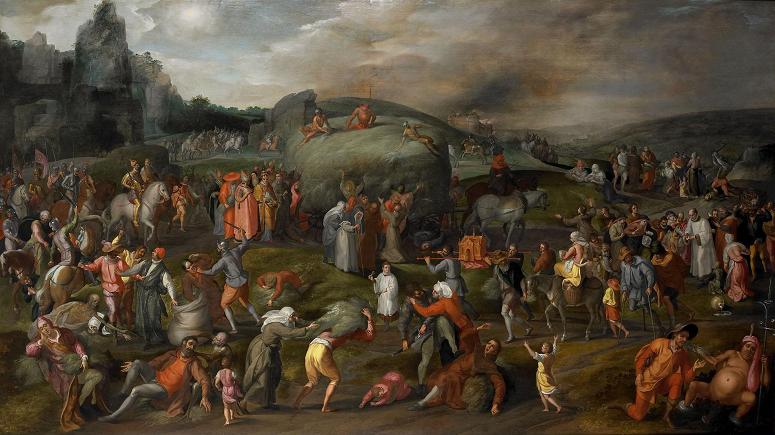Gillis Mostaert (c1529 - 1598). Gillis Mostaert the Elder was a Flemish Renaissance painter and draughtsman active in Antwerp in the second half of the 16th century. He was a versatile artist who worked in various genres including landscape, genre and history painting. Gillis Mostaert was known in particular for his winter landscapes and his scenes with fires and nocturnal scenes and his works in this genre were among the most sought after pieces of his time. The artist operated a large workshop in Antwerp, which supplied works to prominent patrons. He was a regular collaborator with leading Antwerp artists of his time. Gillis Mostaert was born in Hulst. According to the early artist biographer Karel van Mander Gillis Mostaert was the twin brother of the painter Frans Mostaert and the grandson of the painter Jan Mostaert. Modern scholarship casts doubt on the statement that Jan Mostaert was a relative of Gillis. Gillis' father, also called Gillis, was a painter himself. While his brother Frans became a pupil of the landscape painter Herri met de Bles, Gillis studied landscape painting with Jan Mandijn from 1550, the year he was registered as a pupil in the Antwerp Guild of Saint Luke. Van Mander recounts that both brothers joined the Antwerp Guild of Saint Luke in 1555. However, since Frans received a registered pupil in 1553 it is more likely that Frans had become a master in the Guild earlier. It is suspected that Gillis worked along Marten van Cleve and Maerten de Vos in the studio of Frans Floris, the leading Antwerp history painter of his time. Gillis Mostaert married Margareta Baes in 1563 and the couple had six children. He was well-respected by his fellow painters. The painters Peeter Baltens and Crispin van den Broeck were godfathers to his children born in 1571 and 1588. Mostaert established a thriving workshop in Antwerp and his work commanded high prices in the market. Inventories of art collections from most important collectors of the late 16th and early 17th centuries list many expensive cabinet paintings of Mostaert, which shows that his work received patronage of prominent and well-off private clients. These collectors included Francois Perrenot de Granvelle, Archduke Ernest of Austria and Archduke Leopold Wilhelm of Austria. Filips van Valckenisse who was the Lord of Hemiksem, head of the Antwerp militia and perhaps Antwerp's greatest art collector owned over 50 paintings by Mostaert. He died in Antwerp. It is believed that he was heavily indebted at the time of his death and that the contents of his workshop was sold off or distributed to creditors to pay off these debts. Many of his works were acquired by Filips van Valckenisse, lord of Hemiksem, who still owned a number of these when he died himself in 1614. Very few works can be attributed with certainty to Gillis Mostaert as he signed few of his paintings. He added usually the monogram GM and the year on those works that he signed. Mostaert likely operated a large workshop with an important output. He seems to have worked mainly for private clients to whom he supplied pictures in a wide range of subjects. These included scenes of markets, fairs and village, allegories of the four seasons, winter and snow landscapes, scenes of war, hell and burning houses, religious subjects as well as parables and allegories. Mostaert often used copper as a support for his oil paintings, which gives them a certain luster or glowing appearance. Mostaert is believed to have played an important role in the development in Antwerp of genre and landscape art, through his scenes depicting the activities of contemporary people by means of the many small figures in his compositions. He is further credited with the introduction into genre art of the Mannerist style of representing the human figure that was typical for the Antwerp Mannerists of the Frans Floris School. Key characteristics of this emerging style are the natural depiction of nature and reflecting surfaces, the inclusion of various small figures to animate his canvases and the blending of landscape with history. He was in his time known for the wit displayed in his works. He reportedly painted a Resurrection of Lazarus, which included a self-portrait of himself amongst the crowd holding his nose so as not to smell Lazarus' smell of decay. He was thus regarded as continuing a Flemish artistic tradition of which Hieronymus Bosch was the earliest representative and of which his contemporary Pieter Bruegel the Elder was another example. He was active as an imitator of Hieronymus Bosch. For his Bosch-inspired compositions he drew his main inspiration from one of the five tapestries after Bosch that were woven for Cardinal Granvelle in Brussels in 1566.
more...













